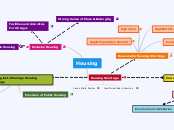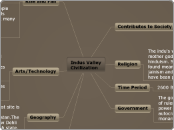Low Level of Health
Lack of basic services such as clean drinking water and proper sanitation make people vulnerable to diseases.
1) People drinking water from contaminated sources (polluted wells and rivers) may suffer from cholera and diarrhea.
2) Lack of waste management facilities result in improper disposal of rubbish. (Eg. in drains) This clogs the drains and allow mosquitoes to breed, spreading diseases like malaria and dengue fever.
Environmental Pollution
1) Water Pollution
Rivers near slums may be used for washing, garbage and sewage disposal. Contaminants from sewage may also seep into the ground and pollute nearby water sources such as wells.
2) Land Pollution
The lack of garbage disposal system results in the dumping of garbage into open areas and drains. The garbage can generate foul smells and become an eyesore.
Affordable Housing
There are a variety of housing types to cater to different income groups and different family sizes. (Eg. 3/4/5 room flats, condominiums, terraces, bungalows)
These houses are made affordable by financial schemes. (Eg. Additional CPF Housing Grant: families not earning more than $5000 a month can qualify for a $40000 grant to pay for their flat) This especially helps for low-income families.
Strategies to Manage Housing Shortage
Slum Upgarding
1) Government helps to build better houses for people living in slums using better quality materials. (Eg. Bricks / Concrete) People will have to move temporarily as the government would have to tear down the existing slums to build better houses.
2) Self-Help Schemes
Government provides people with better materials at a lower cost so that people can upgrade the slums on their own. They can upgrade their slums while still living in their homes but can only do so during their free time. The government provides training so that people would have the skills to upgrade their own homes.
Examples:
1) Nairobi, Kenya (Clearing of clogged drains, building of concrete homes)
2) Rio De Janeiro, Brazil (75% of homes now have electricity)
Provision of Public Housing
The government provide houses with basic services especially for low-income households, the elderly and disabled. These houses can also be subsidized by the government so that people can afford to buy them.
Eg. Housing Development Board in Singapore.
The HDB cleared slums and dilapidated houses in the 1960s to make space for high-rise public housing. This was due to the increase in immigrants to Singapore at that time resulting in the need for more houses.
Strong Sense of Place & Belonging
A sense of place refers to the meaning and value people attach to a place as a result of their experiences or the unique characteristic of a place.
People may find a place special for different reasons. (Eg. Playing at a playground when he/she was young, Malay wedding at a particular void deck, distinctive features such as parks and monuments)
Facilities and Amenities
For All Ages
Range of facilities and amenities for different age groups. (Eg. 3-Generation facilities)
Young: Playgrounds, Child-care Center
Adults: Park, Fitness Corner, Food Courts
Elderly: Elderly Fitness Corner, Senior Activity Center.
Consequences of Housing Shortage
Slums & Squatter Settlements
Homelessness
There is a lack of shelter and people would have to sleep on the streets on under infrastructures such as bridges.
These people are expose to harsh weather elements such as cold or rain which will affect their health.
They also do not have food to eat and may have to search for food in trash bins. This will also affect their health.
Reasons for Housing Shortage
If the supply of houses cannot meet the demand, housing shortage will occur.
Rapid Population Growth
There is an increase in global population with many of them living in cities. (Urbanisation)
Cities in Asia and Africa growing rapidly.
With more people living in cities, more houses are needed.
Migration
Migration refers to the movement of people from one area to another. (Rural-Urban Migration)
People are moving from the villages to the cities for different reasons.
(Pull Factors: Better Jobs, Better Education, Better Medical Facilities, Peace and Stability)
(Push Factors: Wars, Famine)
Limited Land Supply
Cities may have limited land suitable for housing due to physical features. (Eg. Seas, Rivers, Mountains)
Flat land is preferred for housing as the cost of construction on steep slopes is high. Landslides may also occur if houses are built on slopes.
Competing Land Use
There are many uses for land. (Eg. Residential, Commercial, Industrial, Recreational)
Land is also needed for infrastructure. (Eg. roads, airports, hospitals)
Therefore there may be a lack of land being set aside for housing especially when a land set aside for a particular use may not be used for another. (Eg. Land set aside for industries cannot be used for housing)
High Birth Rates
Cities have a large proportion of people in their 20s and 30s who are likely to start families.
Higher birth rates result in bigger families and the need for more houses.
Vulnerability
1) Vulnerable to Fires
Slums & squatter settlements made from recycled materials that are flammable.
2) Vulnerable to Landslides
Densely populated areas have slums built on steep slopes and are at risk of landslides especially after a heavy rain.
3) Vulnerable to Eviction
Slums & squatter settles may be build on land without the permission of the government. People staying in these areas face the risk of being forced out of their homes.
Housing
Inclusive Housing
An inclusive city is one that provides residents with adequate housing, access to basic services (Eg. transportation / recreation) and where residents feel a sense of belonging to the community.
(Specific to Singapore)
Subtopic
Housing Shortage
Housing shortage occurs when there is insufficient housing to accommodate the population in an area. (Supply cannot meet the demand)
Insufficient Basic Services
Lack of access to basic services. (Eg. electricity, clean water, proper sanitation, waste disposal)
Lack of infrastructure. (Eg. power lines, water pipes, toilets, waste management facilities)
Lack of Safe Shelter
Houses in slums have weak foundations, unstable and are made from poor quality materials. (Eg. zinc, cardboard)
Cannot protect people against weather elements and natural disasters









